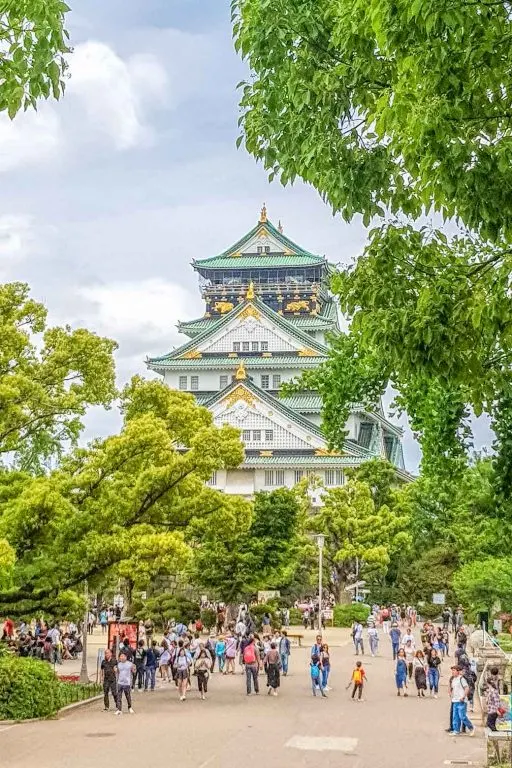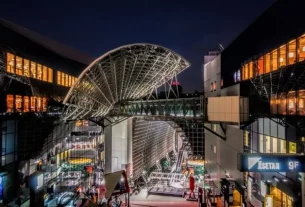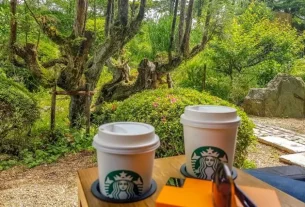There are many reasons why Japanese castles should be part of your travel plans. They are architecturally both beautiful and impressive, they are often associated with some of the most stunning gardens in the country and they provide a glimpse back into the feudal age, the time of Shoguns, Samurai, Ninja and Geisha.

When we are going to be passing anywhere near a castle that we haven’t explored before it’s almost impossible to resist the temptation to add it to the itinerary. Part of the reason is probably that I’ve read way too many Japanese novels.
I love to visualise the world of the samurai and ninjas as we wander through these historic sites, discover the subtle song of the Nightengale floors and spot ornate and meaningful details. The castles do look a lot different than they did in their feudal heyday of course. The best-preserved segments are usually the moats and fortifications such as the walls, turrets and occasionally the castle towers but extensive work has gone into authentically recreating other segments as they were in centuries past.
Many of the castles you will see in Japan are recreations, sections of the castle that were rebuilt from the ruins when castles were destroyed by war, extreme weather conditions, fire or the systematic demolition set out by the Haijō Edict under Emperor Meiji as part of the unification of Japan in a symbolic end to the Feudal Age.
Table of Contents
Why visit a Japanese castle?
Historic value
The Japanese castles evolved from earlier fortifications over the centuries but the more dramatic structures we admire today generally date from the 16th century. Coming from Australia, an ancient land itself but with its earliest surviving man-made structures dating from the late 18th century, Japan’s shrines, temples and castles fascinate me.
Gardens
Japan celebrates its distinct seasons and that is particularly evident in its many beautiful gardens designed to transition beautifully from one season to the next but put the spotlight on a particular flower or feature. The cherry blossom and the autumn leaves are the most notable to visitors but wisteria, azaleas, hydrangeas, iris, pink moss and dozens of others have their moments to shine.
Two of Japan’s self-selected ‘3 most beautiful gardens’, Kōraku-en in Okayama and Kenroku-en in Kanazawa were designed and enjoyed as castle gardens before later being opened to the public. Even those castle gardens that don’t enjoy such recognition are generally still quite beautiful and maintained in keeping with their early design. The Shoguns and aristocracy of the period clearly enjoyed the arts and beauty in their surroundings.
Architectural interest and beauty
The castles vary significantly in their size, styling and placement and while there is consistency in their overall design and fortification their are also may interesting architectural aspect and aesthetic features.
Some of the most notable are the inclusion of family crests into the roof and wall tiles or the dramatic protective talismans. Shachihoko is a fish with a lions head that is often placed on both sides of a roof to protect from fire, you will see it distinctively featured at Nagoya Castle and has become a symbol of the city.
Cultural value
I wouldn’t consider myself a history buff at all but I do enjoy the cultural and historical side of visiting castles and the connection of each to the 3 great unifiers of Japan. Almost all of the castles have a connection to at least one of the great warlords, Oda Nobunaga, Toyotomi Hideyoshi, or Tokugawa Ieyasu and they reflect the 3 distinctive characters who shaped modern Japan.
Toyotomi Hideyoshi was a dedicated patron of the arts and intricate design details can be seen in the castles he is connected with and in the festivals connected to those castles. The Nagahama Hikiyama Matsuri for example features young Kabuki actors performing on gilded floats that are pulled through the city streets from the shrine towards the castle. The stunning floats and traditions have been maintained through the centuries.
Original Castles in Japan
There are only 12 original castles remaining in Japan and that makes them extra special and worth going a little out of your way to visit. To qualify they must have retained the castle tower. One of the best things about these castle towns is that they have often preserved significantly more than just the castle itself making them interesting to visit on many levels. The best-known and possibly the most exquisite of the original castles is Himeji Castle which had a significant restoration a few years back to ensure its preservation for the future. It is certainly dramatic especially when viewed surrounded by cherry blossoms, a view we were fortunate enough to enjoy on our first visit in 2010.
A personal favourite though is in the small town of Hikone where both the castle building itself and the stables have survived and that adds an interesting extra element. There’s a wonderful historic shopping street that leads away from the castle down towards Lake Biwa which is now mostly restaurants and the like but well worth following down to the lake. We visited Hikone Castle in the winter so it wasn’t the best time to enjoy what I understand are some excellent gardens but to see it covered in snow had quite an impact too although that tower floor was darn cold though your socks.
The full list of original Japanese castles includes:
- Bitchu Matsuyama – also known as Takahashi Castle (Okayama Prefecture)
- Himeji (Hyogo prefecture – National Treasure)
- Hikone (Shiga prefecture – National Treasure)
- Hirosaki (Aomori prefecture)
- Inuyama (Aichi prefecture – National Treasure)
- Kochi (Kochi prefecture)
- Marugame (Kagawa prefecture)
- Maruoka (Fukui prefecture)
- Matsue (Shimane prefecture – National Treasure)
- Matsumoto (Nagano prefecture – National Treasure)
- Matsuyama (Ehime prefecture)
- Uwajima (Ehime prefecture)
To be classed as an original castle means that the main castle keep is intact as it was at the time of the Meiji Restoration in 1868. Many of the ‘recreated’ castles include original structures such as warehouses, turrets, walls, moats and other fortifications but their main castle tower has been rebuilt with varying degrees of authenticity.
Of these 12 original castles, there are five with National Treasure status. These are Himeji, Hikone, Matsumoto, Inuyama and Matsue.
10 incredible Japanese castles to visit
These castles don’t all have original castle buildings from the feudal period, some have had the main castle recreated in modern times, and others have enough other interests to make them worth visiting despite their lack of the castle tower. I plan to add to our collection of Japanese castles visited over time, but these 10 would be our recommendations so far.
Something different about visiting Japanese castles from those in Europe is that except for the odd room or scene, they are largely empty or house museum exhibits. They aren’t furnished and don’t provide direct insights into the comforts or lack of it that the inhabitants would have enjoyed during their heyday. The structures are incredible and beautiful but what it would have been like to have lived or worked within them is largely left to your imagination.
This is something I’ve heard many people, especially those who have visited castles and stately homes in Europe comment on. I love to read Japanese historical fiction, so it’s not hard to allow the reel to play in your head imagining what it must have been like but I’ve often thought it a shame that there isn’t more visual inside them to suggest how the various spaces were used. They have of course been stripped bare and unoccupied for 100-150 years at this point so the structures being so well preserved in themselves is impressive.
1. Himeji Castle
Himeji Castle is one of only 12 original castles with the main castle tower remaining, it is a National Treasure and is widely recognised as one of the top three castles in Japan. It’s also my number one as it was the first we visited and fired a passion for travelling further from the beaten path to find more. Our visit here was as the cherry blossoms just passed their peak and against a clear blue sky. It is a stunning sight.

As you explore you have excellent access to see all the impressive fortifications around the castle and grounds including openings in the wall called ‘Musha Otoshi’ from inside the castle keep and west bailey (Nishinomaru) where the princesses lived. These openings were a last line of defence placed there to drop boiling water, oil and rocks down on would-be attackers. Perhaps it is because it was so impressively fortified, that Himeji-jo never came under attack.
If you are at Himeji castle during the cherry blossom season you’ll want to linger around the great lawn in the Sannomaru through the Otemon gate. It’s lined with cherry trees that frame stunning views of the castle. This part of the castle grounds is open to the public and free to enter, beyond is a ticket gate at the Hishi gate to see the inner parts of the castle grounds and enter the buildings.
Planning your visit to Himeji Castle
2. Hikone
As mentioned above, Hikone is a personal favourite, it is an original castle and while far smaller than Himeji it is beautiful in its own right. Amongst the other structures still standing in Hakone are the horse stables which are located just outside the inner moat that surrounds the castle and are the first part you come to.
Huge chunks of snow were melting and sliding from the roof of the stables onto the footpath as we arrived and the whole area really was picture perfect.

The views from the top floor of the castle out to Lake Biwa are spectacular and we had a wonderful afternoon wandering the historic shopping street down towards the lake afterwards. I’m told the gardens are also worth allowing some time for but they were under a layer of snow while we were here in February.
It’s a lovely little town and well worth stopping in at. It can easily be incorporated if you are travelling up to either Nagahama or Kanawawa by train from the central cities of Osaka and Kyoto.
Planning your visit to Hikone Castle
3. Matsumoto
Like all of the Japanese castles featured here, Matsumoto Castle was built during the warring states period but unlike most, it has not seen battle during its 400-year history, instead to many it now represents the region’s quest for peace and stability across the ages.
The flatland castle is known as the black crow castle and is quite distinctive although it does feature both black and white in its facade. The design choice is said to be a mark of respect from Lord Ishikawa to Toyotomi Hideyoshi whose Osaka Castle at the time was also black.
Matsumoto Castle is stunning viewed across the wide moat and is one of the most complete with a secondary donjon (castle tower) and defensive turret adjoining the main castle keep that dates back to 1592. While the castle presents as having 5 tiers there is a 6th hidden floor inside
4. Inuyama
In Aichi, only a 30-minute train trip from Nagoya city is Inuyama. This is another of the original castles and well worth a visit to enjoy the Yamajiro or mountain castle looking out over the impressive Kiso River below and the lovely castle shopping street and town that surround it.
The castle was rebuilt several times between the mid-1300s and 1500s but what we see preserved on the site today was largely the work of Oda Nobunaga’s son, Oda Nobutasu.
All three of Japan’s 3 great unifiers had a history with Inuyama Castle. Oda Nobunaga took the castle twice, once in 1560 and again in 1564, after his death Toyotomi Hideyoshi had the castle defences rebuilt in a more contemporary design and then in 1600 Tokugawa Ieyasu took the castle in the Battle of Sekigahara.
5. Hiroshima
There was a 13th original castle at Hiroshima that survived until modern times. It avoided demolition in the Meiji Restoration but was lost on the 6th of August 1945 when an atomic bomb was detonated over the city at the end of WWII. The city was rebuilt in the years that followed along with the castle in 1958.

Remains of the original foundations can be seen throughout the expansive castle grounds and during sakura the edge of the moat is a popular place for locals to relax and enjoy the cherry blossoms.

6. Okayama
Okayama castle is another recreation but this one is special as much of the extensive castle gardens have also been preserved as the castle itself, they are known as Korakuen and are recognised as one of the 3 most beautiful gardens in Japan.

While the castle looks out across the inner moat to the garden, the garden itself enjoys impressive vistas of the castle from various points around it. Features such as the Ryuten Rest House located on a stream within the garden were features of feudal times that are still represented in the garden today.
If you are headed to Okayama the Korakuen Garden should be on your list, it is easily accessible from the Shinkansen station where there are plenty of lockers to leave your bags if you are just stopping off on your journey. I
f you have some extra time then a short train trip from the centre of Okayama to Kurashiki Bikan, a historic merchant town built around the canal is another part of the city worth adding to your itinerary.
7. Kanazawa
Kanazawa Castle is well known for Kenrokuen Gardens, another of the top 3 gardens in Japan. The castle itself has had ongoing rebuilding projects underway since the 1990s which have enhanced the original feudal-age remains of turrets, storehouses and fortifications with substantial recreated castle buildings.

8. Nijo
Within the city of Kyoto, we consider Nijo Castle a must-visit spot although what remains of the actual castle fortification is minimal. Some foundations of the main castle, walls and turrets are still here but what Nijo has that makes it so special is the surviving palace, the extensive gardens with double moat and many other historic buildings.

9. Osaka
Osaka is the largest city to have a castle its the central city. As a recreation, it is perhaps one of the less impressive in some ways with its ferroconcrete construction but its impressive positioning in the surrounding park, being visible from the tallest buildings and lookouts like Harukas 360 and the Umeda Sky Building throughout the city and the view from the top of the castle itself giving an encompassing view

10. Nagahama
The town of Nagahama won our hearts on our 2011 winter visit when we made our way out there to attend a bonsai display of cherry and plum trees, an event known as Bonbai, in the historic Keiunkan a venue that played host to Emperors and Princesses. It’s a fabulous town, so friendly, with great food, artisans, impressive festivals and a castle. Not surprisingly we have found an excuse to include a stop here several times since.
The castle in Nagahama sits on the edge of the picturesque Lake Biwa, a spectacular location and although the castle is a recreation it’s a much-loved gathering place for locals to come together, especially during the cherry blossom season.
Escape back in time in the pages of a book
If you are in the dreaming and planning stages of your trip and you like to read there are some good novels set in feudal Japan that might feed your interest in Japanese Castles and that period in Japan’s history. They make a great read and when you do get the chance to visit some of these fabulous spots they come to life in your imagination.
Tales of the Otori is a good place to start. This well-known trilogy by Lian Hearn and comprises:
- Across the Nightengale Floor
- Grass for his Pillow, and
- Brilliance of the Moon
It was subsequently extended with ‘The Harsh Cry of the Heron’ set 17 years later bringing in the story of Lord Takao Otori’s children and a prequel ‘Heaven’s Net is Wide’, the story of Lord Shigaru up to the point where he met Takao.
The fictional work is set amongst the intrigue, brutality and complexities of feudal Japan, the world of shoguns and samurai, concubines and ninjas.
Another read to satiate an interest in Japan’s history and culture is The Tale of Genji. Set in the 11th century it is believed to be the world’s first novel and written over 1000 years ago. It was penned by a noblewoman, a lady-in-waiting within the Court but don’t expect it to be all prim and proper, Murasaki Shikibu didn’t shy away from the scandals of the aristocracy.
If you get caught up in this one you’ll want to include a stop at Uji in Kyoto, it’s an easy day trip from the city and has many connections to the novel. I was also wowed by the incredible detail in a display of painted screens depicting scenes from the book at Nezu Museum in Shibuya. While that exhibit was temporary I’d highly recommend a visit to the museum, gardens and teahouse.
A few tips for visiting Japanese castles
- If you want to visit castles from a base within a major city then Kyoto is an excellent choice. There are many great day trips from Kyoto and the original castles of Himeji and Hikone can both be reached easily from there along with Korakuen, the castle garden at Okayama recognised as one of Japan’s top 3 gardens.
- If you are planning to travel around between cities on day trips or a round trip then one of the Japan Rail Passes has previously been an excellent choice, since late 2023 it rarely pays off but we have the information here to work out if a JR pass is worth it for your itinerary. It is still easy to get around Japan even without the pass.
- Many of the smaller castle towns have a wonderful feel to them and in addition to the castle, gardens and any associated museums it’s worth seeking out the historic street leading up to the castle as these are often well preserved and can include some excellent restaurants and teashops. They won’t necessarily be the way you come in from the station but they won’t be hard to find.



